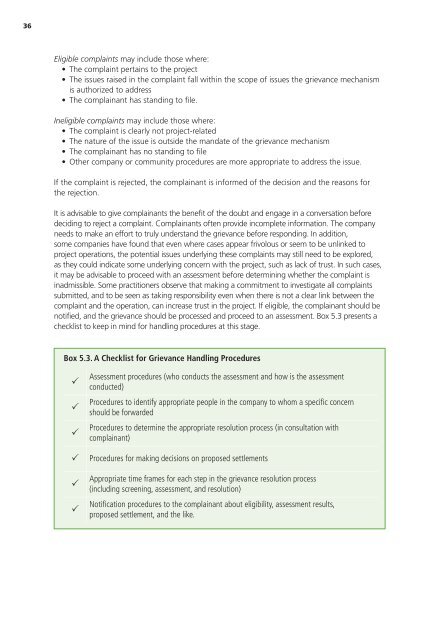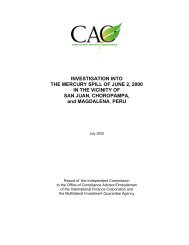A Guide to Designing and Implementing Grievance Mechanisms for ...
A Guide to Designing and Implementing Grievance Mechanisms for ...
A Guide to Designing and Implementing Grievance Mechanisms for ...
You also want an ePaper? Increase the reach of your titles
YUMPU automatically turns print PDFs into web optimized ePapers that Google loves.
36<br />
Eligible complaints may include those where:<br />
• The complaint pertains <strong>to</strong> the project<br />
• The issues raised in the complaint fall within the scope of issues the grievance mechanism<br />
is authorized <strong>to</strong> address<br />
• The complainant has st<strong>and</strong>ing <strong>to</strong> file.<br />
Ineligible complaints may include those where:<br />
• The complaint is clearly not project-related<br />
• The nature of the issue is outside the m<strong>and</strong>ate of the grievance mechanism<br />
• The complainant has no st<strong>and</strong>ing <strong>to</strong> file<br />
• Other company or community procedures are more appropriate <strong>to</strong> address the issue.<br />
If the complaint is rejected, the complainant is in<strong>for</strong>med of the decision <strong>and</strong> the reasons <strong>for</strong><br />
the rejection.<br />
It is advisable <strong>to</strong> give complainants the benefit of the doubt <strong>and</strong> engage in a conversation be<strong>for</strong>e<br />
deciding <strong>to</strong> reject a complaint. Complainants often provide incomplete in<strong>for</strong>mation. The company<br />
needs <strong>to</strong> make an ef<strong>for</strong>t <strong>to</strong> truly underst<strong>and</strong> the grievance be<strong>for</strong>e responding. In addition,<br />
some companies have found that even where cases appear frivolous or seem <strong>to</strong> be unlinked <strong>to</strong><br />
project operations, the potential issues underlying these complaints may still need <strong>to</strong> be explored,<br />
as they could indicate some underlying concern with the project, such as lack of trust. In such cases,<br />
it may be advisable <strong>to</strong> proceed with an assessment be<strong>for</strong>e determining whether the complaint is<br />
inadmissible. Some practitioners observe that making a commitment <strong>to</strong> investigate all complaints<br />
submitted, <strong>and</strong> <strong>to</strong> be seen as taking responsibility even when there is not a clear link between the<br />
complaint <strong>and</strong> the operation, can increase trust in the project. If eligible, the complainant should be<br />
notified, <strong>and</strong> the grievance should be processed <strong>and</strong> proceed <strong>to</strong> an assessment. Box 5.3 presents a<br />
checklist <strong>to</strong> keep in mind <strong>for</strong> h<strong>and</strong>ling procedures at this stage.<br />
Box 5.3. A Checklist <strong>for</strong> <strong>Grievance</strong> H<strong>and</strong>ling Procedures<br />
�<br />
�<br />
�<br />
Assessment procedures (who conducts the assessment <strong>and</strong> how is the assessment<br />
conducted)<br />
Procedures <strong>to</strong> identify appropriate people in the company <strong>to</strong> whom a specific concern<br />
should be <strong>for</strong>warded<br />
Procedures <strong>to</strong> determine the appropriate resolution process (in consultation with<br />
complainant)<br />
� Procedures <strong>for</strong> making decisions on proposed settlements<br />
�<br />
�<br />
Appropriate time frames <strong>for</strong> each step in the grievance resolution process<br />
(including screening, assessment, <strong>and</strong> resolution)<br />
Notification procedures <strong>to</strong> the complainant about eligibility, assessment results,<br />
proposed settlement, <strong>and</strong> the like.





